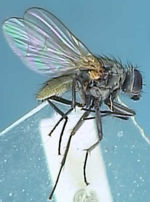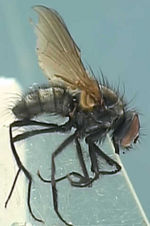Difference between revisions of "Hydrotaea irritans"
Jump to navigation
Jump to search
| Line 38: | Line 38: | ||
**Secondary bacterial infection may occur | **Secondary bacterial infection may occur | ||
**[[Blowfly Strike|Blowfly strike]] may follow | **[[Blowfly Strike|Blowfly strike]] may follow | ||
| − | + | ||
| − | + | ||
| + | [[Category:Nuisance Flies]] | ||
Revision as of 12:41, 5 April 2010
- Also known as the 'head fly'
- Hydrotaea irritans the main species of veterinary importance
- Mainly a problem of sheep
- In some areas it is the most numerous fly of cattle and horses
Recognition
- Similar to Musca spp.
- Olive green abdomen
- 4-7mm in length
Life Cycle
- Eggs laid in decaying vegetation, faeces and in carrion (in the summer months)
- Emerging larvae overwinter (diapause) and pupate in spring
- Adult flies emerge in the summer
- One generation per year
Pathogenesis
- Cattle
- Evidence suggests that they transmit summer mastitis
- Sheep
- Cause extreme irritation
- Mouthparts rasp the skin to feed on secretions and exudate
- Leads to self-inflicted damage
- E.g. 'Broken Head'
- Secondary bacterial infection may occur
- Blowfly strike may follow
- Cause extreme irritation

